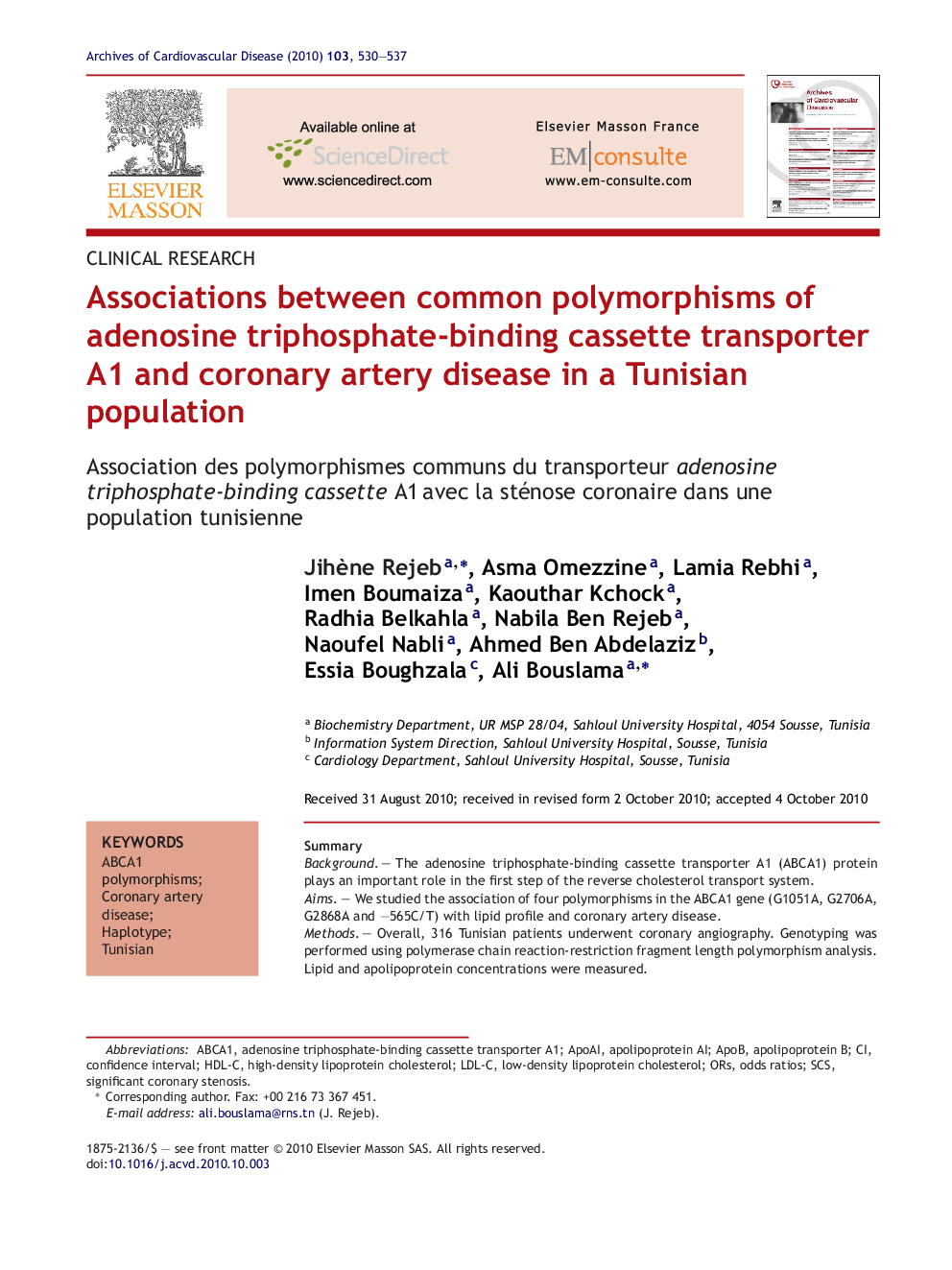| Article ID | Journal | Published Year | Pages | File Type |
|---|---|---|---|---|
| 2889858 | Archives of Cardiovascular Diseases | 2010 | 8 Pages |
SummaryBackgroundThe adenosine triphosphate-binding cassette transporter A1 (ABCA1) protein plays an important role in the first step of the reverse cholesterol transport system.AimsWe studied the association of four polymorphisms in the ABCA1 gene (G1051A, G2706A, G2868A and –565C/T) with lipid profile and coronary artery disease.MethodsOverall, 316 Tunisian patients underwent coronary angiography. Genotyping was performed using polymerase chain reaction-restriction fragment length polymorphism analysis. Lipid and apolipoprotein concentrations were measured.ResultsOnly carriers of the G2706A allele were associated with a decreased risk of significant stenosis (odds ratio [OR] 0.66, 95% confidence interval [CI] 0.22–0.92, p = 0.029), without pronounced effects on high-density lipoprotein (HDL) cholesterol. This protective effect was significant in smokers and diabetes. Carriers of the G1051A allele were associated only with increased concentrations of HDL cholesterol (p = 0.032). G2868A and –565C/T did not show any association with lipids or risk of significant stenosis. When ABCA1 polymorphisms were combined in haplotypes possessing G1051A, G2706A, G2868A and –565C/T, (AAGC) seemed to be most protective against significant stenosis (OR 0.5, 95% CI 0.29–0.96, p = 0.048) whereas (GGAT) was probably the most atherogenic (OR 1.26, 95% CI 1.03–1.56, p = 0.025).ConclusionOnly the G2706A allele seems to be associated with a reduced risk of significant stenosis without important modification of HDL-cholesterol concentration, and appears to be more protective for smokers and diabetic patients. We found that (AAGC) seems to be a protective haplotype whereas (GGAT) has an atherogenic effect in a Tunisian population.
RésuméContexteLe transporteur adenosine triphosphate-binding cassette A1 (ABCA1) joue un rôle important dans le transport inverse du cholestérol.ObjectifsÉtude de l’association de quatre polymorphismes (G1051A, G2706A, G2868A, –565C/T) au niveau du gène ABCA1 avec le profil lipidique et la sténose coronaire dans notre population d’étude.MéthodesNous avons recruté 316 patients, documentés par coronarographie. Le génotypage a été réalisé par polymérisation en chaîne suivie de digestion par enzymes de restriction. Les paramètres lipidiques et apolipoprotéiques ont été dosés.RésultatsSeulement l’allèle G2706A a été associé à une diminution du risque coronarien (OR 0,658, 95 %IC 0,22–0,92, p = 0,029), sans effets prononcés sur HDL-C. Cet effet protecteur a été surtout significatif chez les fumeurs et les diabétiques. Les polymorphismes G2868A et –565C/T n’ont montré aucune association avec le profil lipidique ou avec la sténose coronaire. L’allèle G1051A a été seulement associé à une augmentation de HDL-C (p = 0,032). En combinant les polymorphismes ABCA1 (G1051A, G2706A, G2868A, –565C/T) en haplotypes (AAGC), semble être l’haplotype le plus protecteur contre la SCS (OR 0,5, 95 %IC 0,29–0,96 ; p = 0,048) tandis que (GGAT) serait le plus athérogène (OR 1,26, 95 %IC 1,03–1,56, p = 0,025).ConclusionL’allèle G2706A semble être associé au risque réduit de sténose coronaire sans modification importante de HDL-C. Cet effet protecteur est plus prononcé chez les fumeurs et les diabétiques. Parmi, les AAGC semblent être protecteur et (GGAT) serait athérogène dans notre population d’étude.
